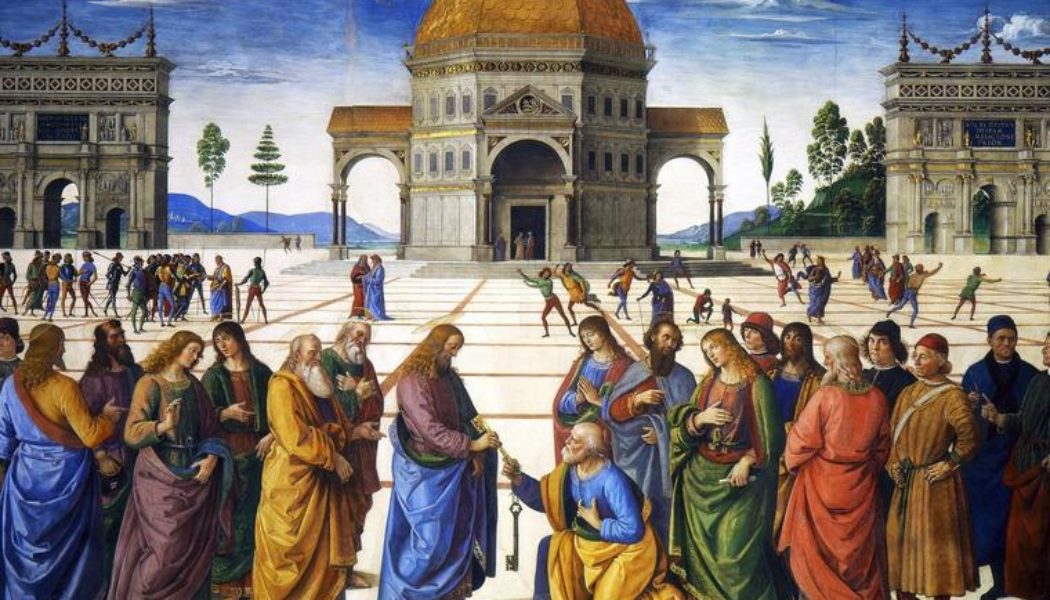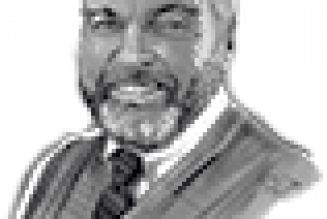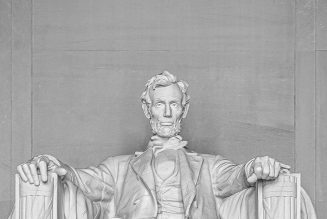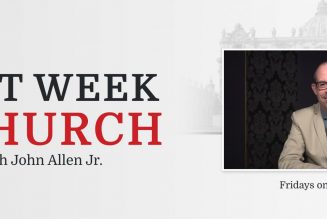
This month has been witness to two key Christological Gospels. The Gospel of the Transfiguration reveals vital truths about who Jesus is and our possible share in him. Today’s Gospel again tells us who Jesus is and what is Peter’s role in the Christian community.
Jesus and his Apostles have come to Caesarea Philippi, still in the far north of what we today call Israel, near the Golan Heights. Jesus asks his Apostles two questions. They seem similar, even parallel. They could not be more different.
“Who do people say that the Son of Man is?” Jesus has been preaching for some time. He’s been accepted by some, rejected by others. Some have attached themselves to him out of a budding commitment; others for transitory benefits, like bread. “Son of Man,” a title Jesus has taken and adapted to himself, in common Hebrew parlance basically meant “a human being.” (“Man” is humanity and “son of” was Semitism to individuate a particular person within that mass of humanity. That Jesus is the human being par excellence is why we should speak of him as the “Son of Man”).
So Jesus is basically asking for a report: “What are people saying about this Son of Man, me? What are you hearing? You’re on the road, you mingle among the people. What’s the word on the street?” As Father John Paul Heisler notes, Jesus often engages with the off-the-record conversation. Remember on Corpus Christi how Jesus continues his Eucharistic discourse by responding to “the Jews [who] quarreled among themselves” (John 6:41, 43)?
And the Apostles give him a report — at least insofar as those who have good things to say about Jesus. “Some say John the Baptist, others Elijah, still others Jeremiah or one of the prophets.”
By this point in Matthew’s Gospel, John is dead. John’s execution preceded Jesus’ multiplication of the loaves and his northern expedition, from Peter’s walk on the Sea of Galilee to Gennesaret to Tyre and Sidon to Caesarea Philippi.
According to Jewish tradition Elijah, the first and head of the prophets (which is why we met him on the Transfiguration), was taken into heaven in a fiery chariot (2 Kings 2:1-11) and was expected to return in advance of the Promised Messiah. Jeremiah, the prophet who preached on the eve of Jerusalem’s destruction, was one of Israel’s major prophets. So, word on the street was that Jesus was part of Israel’s prophetic tradition, maybe even the advance prophet of the returning Messiah, given the eschatological expectation that ran high in Roman-subjugated Israel in Jesus’ day.
Jesus’ second question is, “But who do you say I am?”
Perhaps outwardly similar, this second question is fundamentally different. Any reporter could have answered the first question. But Jesus’ second question involved a personal commitment. It was not just a dry recital of facts but required taking a stand.
Simon Peter takes the stand: “You are the Christ, the Son of the Living God.”
Simon Peter confesses Jesus as “the Christ,” God’s anointed one, the one who is to come, the “Son of the Living God.” Jesus is no mere prophet, no elevated moral teacher, no Semitic Confucius.
Jesus blesses Simon Peter, while admitting that his acknowledgment, his confession, is not some particularly perceptive insight by the fisherman from Galilee: “Flesh and blood has not revealed this to you, but my heavenly Father.”
Peter having confessed Jesus’ identity, Jesus now changes Peter’s. “I say to you: You are Peter, and upon this rock I will build my Church and the gates of hell shall not prevail against it. I will give you the keys to the kingdom of heaven. Whatever you bind on earth shall be bound in heaven; and whatever you loose on earth shall be loosed in heaven.”
What a significant paragraph!
First, Jesus changes Simon Peter’s identity by changing his name. “You are Peter.” English does not capture the wordplay as, say, French, where “Pierre” is the name and “pierre” is a stone or rock. When God gives a new mission, it is usually accompanied by a name change (“Abram” → “Abraham,” “Jacob” → “Israel”) because, in contrast to our day, names in antiquity were held to express something of the person. Also in contrast to contemporary mentality, our identity came from and could only be changed by God on his initiative, not a human one.
Second, Peter — the “rock” — is to be the rock on which the Church is built. Peter and his 265 papal successors are not just historical accretions, traditions, maybe even impediments to the Church: their office is essential to the Church, even if they — starting with the first pope — might not always have been the firmest of rocks.
Third, “the gates of hell will not prevail against it.” The Church has a divine insurance policy. Her survival does not depend even on the “rock.” It was, I think, Boccaccio who observed that one needed only to look at the decadence of Rome and the papacy in his day to understand that the Church stood on divine guarantees, because a purely human foundation would have long ago collapsed. Those divine guarantees should also motivate our love for and commitment to the Church. God willed this institution to exist. If we claim to be following God, do we give the Church the same commitment God did?
Fourth, the power of binding and loosing. Jesus will repeat essentially those same words in John 20:23, a text the Church has traditionally understood as the institution of the sacrament of Penance. “Binding and loosing” tells us what the Church is for: to proclaim Jesus’ call to repentance and the forgiveness of sins in order to receive his Gospel. That necessarily means (a) the Church has to be able authoritatively and in a way binding in conscience to teach what is right and wrong and (b) must be able to remove or retain sin.
The Church exists to reconcile men with God. The obstacle to their reconciliation is sin. Therefore, if the Church understands authority over the forgiveness of sins (expressed par excellence in the sacrament of Penance) as being foundational to what the Church is, those who question “why do I have to confess my sins to a priest?” have their argument not with the Church but with Christ and with the order of salvation he established. And if we demand forgiveness on our terms rather than his — well, do we really want forgiveness?
Today’s exceedingly rich Gospel tells us both who Christ and his Church is and poses to us the same existential question asked of the Apostles: “Who do you say I am?”
The Gospel is illustrated by Pietro Perugino (c. 1446-1523), born Pietro Vannucci but nicknamed because of his strong associations with the city of Perugia. The Renaissance painter was a teacher of Raphael. “Christ Giving the Keys of the Kingdom to St. Peter” is a fresco dating from 1481-2. It is generally regarded as both one of the most classic artistic representations of today’s text and of Renaissance art. (See this excellent commentary.)
The painting is divided into three tiers. The main theme of the depiction is in the foreground, divided into two symmetrical groups, meeting in the middle, Christ on the left handing the keys to a kneeling St. Peter. Immediately “backing up” Jesus and Peter are the Apostles. Following the Apostles, dressed in 15th rather than first-century clothing, are Perugino’s contemporaries (including Perugino himself, in black on the right, looking at us). Renaissance art was anachronistic in that way, adding men of its time to those of the scene, witnesses to that ecclesial event.
Two figures in the first rank have their backs to us, drawing us into the center tier. On the left, we see Jesus being challenged over payment of the taxes. On the right, we see one of the attempts to stone Jesus. In both instances, men from the Apostolic age and Renaissance mix together (though more of the latter seem to be exacting Caesar’s tax).
The back tier points us to the Renaissance focus on Antiquity (Renaissance was a “rebirth” of attention to classical Greece and Rome), embodied in the Florentine Baptistery in the middle and repetitions of Rome’s Arch of Constantine on both sides.
The fresco is in the Vatican’s Sistine Chapel.







![Berlin is building a “church about nothing.” Looks like the Communist goal of secularizing East Germany was successful after all [WSJ paywall]…](https://salvationprosperity.net/wp-content/uploads/2021/04/berlin-is-building-a-church-about-nothing-looks-like-the-communist-goal-of-secularizing-east-germany-was-successful-after-all-wsj-paywall-327x219.jpg)

